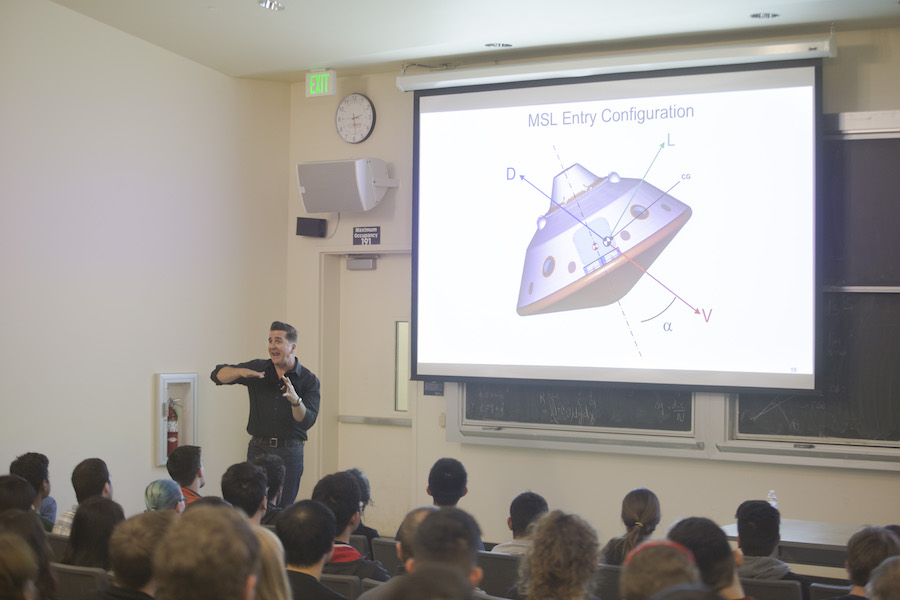
UC Davis alumnus, Chief Engineer for the Mars 2020 mission, speaks to Aggies about what it takes to land on surface of another planet.
Over 185 undergraduates and professors gathered last week to hear Dr. Adam Stelztner, the chief engineer of the upcoming Mars 2020 mission, describe what it takes to make it to Mars. He spoke at a distinguished alumni seminar hosted by UC Davis’ College of Engineering. Steltzner was introduced by former astronaut Stephen K. Robinson, who serves as professor and chair of the Department of Mechanical and Aerospace Engineering at UC Davis.
Steltzner and his team invented a groundbreaking landing system called “the sky crane” that allowed the successful landing of Curiosity, the Mars 2012 rover.
“It was the right kind of crazy,” Steltzner said.
Steltzner is a proud Aggie alumnus. He received his bachelor’s degree in mechanical engineering in 1990 and later his master’s degree in applied mechanics at Caltech, topping it off with a Ph.D. in engineering physics at the University of Wisconsin, Madison. Steltzner was honored with the College of Engineering’s Distinguished Engineering Alumni Medal award and is now the chief engineer for the Mars 2020 mission at NASA’s Jet Propulsion Lab. More specifically, Steltzner leads the Entry, Descent, and Landing team for the Mars rovers.
The sight of the Orion Constellation over San Francisco’s Golden Gate Bridge captivated Steltzner’s imagination at age 21.
“It took that spark of curiosity in the night sky […] and it turned into a fire of exploration,” Steltzner said.
The Mars 2012 mission was sent to answer the question: Was ancient-wet Mars habitable?
“The answer is yes,” Steltzner said. “Three billion years ago, when life was just starting here on Earth, the conditions to support life were on the surface of Mars.”
Curiosity landed on the surface of Mars on August 5, 2012 at 10:32 p.m. PDT. The entry, descent and landing process lasts a total of seven minutes –– from the top of the atmosphere to the planet’s surface. And it takes 14 minutes for the signal from the spacecraft to reach Earth. This seven-minute difference is known as the “Seven Minutes of Terror.” Steltzner spent eight-and-a-half years of his life on this project, and it all came down to those seven minutes.
Entry. When the spacecraft enters the atmosphere, the heat shield glows like a plummeting asteroid traveling at 13,327 miles per hour at a temperature of 1,300ºF –– conditions that can melt or even vaporize most materials. In fact, the heat shield is intentionally shed after penetrating the planet’s atmosphere. The atmosphere of Mars is 100 times thinner than Earth’s and actually changes in density as a function of the planet’s seasons. This adds another layer of complexity to entry.
Descent. Using the largest and strongest supersonic parachute known to man, the spacecraft decelerates to approximately 1,000 miles per hour upon initial drop. From 30 million miles away, the descent was carefully guided by Steltzner’s team, ensuring the rover would land safely on a flat terrain.
Landing. Touchdown engineering was one of the hardest challenges Steltzer’s team faced and took many years to develop a proper plan because the 2012 Curiosity rover is about the size of a Mini Cooper.
“Landing a rover like that, is a pain in the butt. She’s just so big,” Steltzner said.
Previous Mars missions used an airbag technique to land the rovers. But the airbag approach would not sustain the Curiosity’s 900 kilograms. A new approach needed to be made. Steltzner and his team developed NASA’s first “soft landing” technique called “the sky crane maneuver.” Once the parachute is detached, steerable thrusters from the spacecraft finalize the descent and direct the vehicle toward flat terrain. It hovers 21 feet above the Martian surface before releasing Curiosity onto suspension ropes like a marionette.
“We considered [the sky crane] the least unacceptable solution,” Steltzner said.
The touchdown speed was less than 1/1,000,000 of 1 percent of the speed the spacecraft entered the atmosphere. Within seven minutes, the landing was a success. Curiosity determined that the conditions to support life on Mars did exist at some time, but there is still more to explore.
In the upcoming 2020 mission, also led by Steltzner, NASA will gather tangible samples from the planet’s surface, place them in orbit, and bring them back to Earth.
“The Mars 2020 mission is a science fiction come true,” Robinson said.
The first portion of this mission will launch in — you guessed it — 2020.
“I’ve found since that, if I can keep my own curiosity alive, and if I can engender it with the people I work with, we can do better things together,” Steltzner said.
UC Davis Aggies walked away from the seminar full of inspiration. Dorian Crutcher, a fifth-year mechanical engineering major said, “I learned that in order to grow as an engineer I have to take risks and continue to aspire to do things that haven’t been done.”
Written by: David Madey — science@theaggie.org
Editor’s note: An earlier version of this story stated that the name of the chief engineer of the upcoming Mars 2020 mission was Adam Steltzer. It is Adam Steltzner. The article has been updated to reflect this change.



